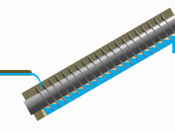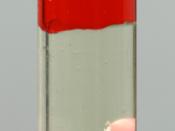Archimedes's Principle Submitted by: Physics Class: 210 Lab section: B Date Performed: 3-13-02 Date Submitted: 3-20-02 Lab Partner: Sample Calculations 1. Weight = mass x 9.80 g/cm^3 W= 45g x 9.80 N W= 44,100 dynes 2. Buoyant force (calculated) = weight in air - weight in water BF = 44,100 dynes - 38710 dynes BF = 5390 dynes 3. Volume of Water = radius^2 x length V= (.63cm) (4.65cm) V= 5.80 cm 4. Buoyant force (measured) = mass in air/ density BF= (44,100 g) / (7.76 g/cm^3) BF= 5684 cm^3 5. % difference = BF calculated - BF measured/ BF measured % difference = 5390 - 5684 / 5684 % difference = 5.4 % 6. Density = Mass / Volume Density = 45 g / 5.80 cm^3 Density = 7.76 g/cm^3 7. Volume of wood = length x width x height V = (7.62cm) (7.63cm) (3.86 cm) V = 224.
42 cm^3 Questions 2.) Because an overweight person displaces more fluid when stepping into a pool. By displacing more fluid, the person creates a greater buoyant force making it easier for him to swim.
5.c) By placing a battery into the water with a floating rod into its deep cylindrical cavity it is quite easy to determine the condition of the battery. The diluted battery will have a much higher density than that of a highly charged battery. From the observation of how the battery floats you can tell its condition.
8.) We were able to find the volume of displace water in Part II quite easily. First we placed a large tupperware container on the table and in it a smaller container filled to the top with water. When the block of wood was placed in the container, water fell out of the smaller container into the larger container. By placing the water which fell out of the smaller container into a cylinder, you are able to measure the volume of displaced water.
9.) No I did not use Archimedes's principal to find the densities. I used the density formula of dividing the mass by the volume. We find the densities and compare them to the densities of water to help understand the mechanics of buoyant force.
Discussion In part two of the lab dealing with Archimedes's principle, we were comparing the buoyant force of a block of wood to its weight in dynes. The first step of the operation dealt with measuring the quantity of displaced water. We did this using two containers, one small and one large, and filled the small container to the brim with water. By placing the block of wood in the small container and using a graduated cylinder, we were able to find the amount of water displaced by the block.
The next step of the procedure was to actually compare the weight of the wood to the buoyant force of the wood in water using Archimedes's principal. According to Archimedes's principal by multiplying the amount of water displaced by the wood by 980 g/cm^3 we could calculate exactly how much buoyant force the wood had in water. We then calculated the percent difference by using the calculated buoyant force and subtracted it from the weight of the wood in dynes, divided it by the weight in dynes and came up with a percent error of 6.8%.
The third and final procedure used in part two of the lab was finding the volume of the wood to figure out it's density in water. By multiplying the blocks length times its width and height we were able to figure out the wood's volume. By dividing this by the wood's mass, we found





